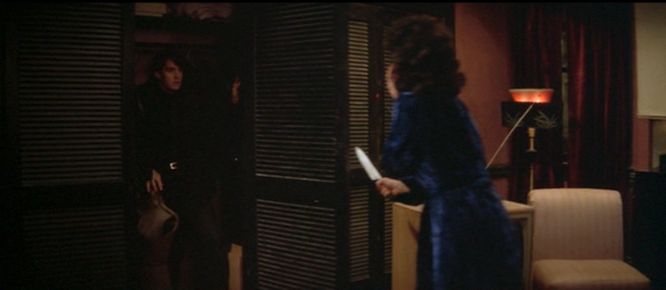 Back to selection
Back to selection
The Blue Velvet Project
Blue Velvet, 47 seconds at a time by Nicholas Rombes
The Blue Velvet Project, #49

Second #2303, 38:23
In Roberto Bolaño newly published story “The Colonel’s Son,” the narrator describes a zombie movie he’s recently seen on TV. In fact, the entire story is a sordid summary of the movie, introduced like this:
I swear it was the most democratic, the most revolutionary film I’d seen in ages, and I don’t say that because the film in itself revolutionized anything; not at all, it was pathetic really, full of clichés and tired devices, yet every frame was infused with and gave off a revolutionary atmosphere . . .
At the moment of this frame, second #2303, Dorothy with her kitchen-drawer knife commands Jeffrey: “Get out of there! Get out! Put your hands up! On your head! Do it! Get on your knees! Do it!” The frame abounds in Hollywood myths and reversals of myth: the woman with the phallic knife, turning the tables on the whole history of who is stabbing who. In Psycho, the knife wielder was a man dressed as a woman in a scene so violent that the film’s editing corresponded to the rapid stabbing. In Blue Velvet, the violence unfolds in a languid long take that humanizes both Dorothy (whose terror and rage at Frank is displaced onto Jeffrey) and Jeffrey (who sees in Dorothy the expression of his own desires), and if the work of the film is anything it is this: to render us somehow less (not more) human, in a way that only movies and books and art can, offering a temporary escape from the relentless identification with ourselves, or in the words of the poet Dana Levin: “this is what we must strive for, / to be the snipers asleep above the insomniac town.”
And so there it is: Blue Velvet, separated from us only by the thin membrane of the screen, something that Dorothy’s gleaming knife, in this frame, threatens to pierce.
Over the period of one full year — three days per week — The Blue Velvet Project will seize a frame every 47 seconds of David Lynch’s classic to explore. These posts will run until second 7,200 in August 2012. For a complete archive of the project, click here. And here is the introduction to the project.
